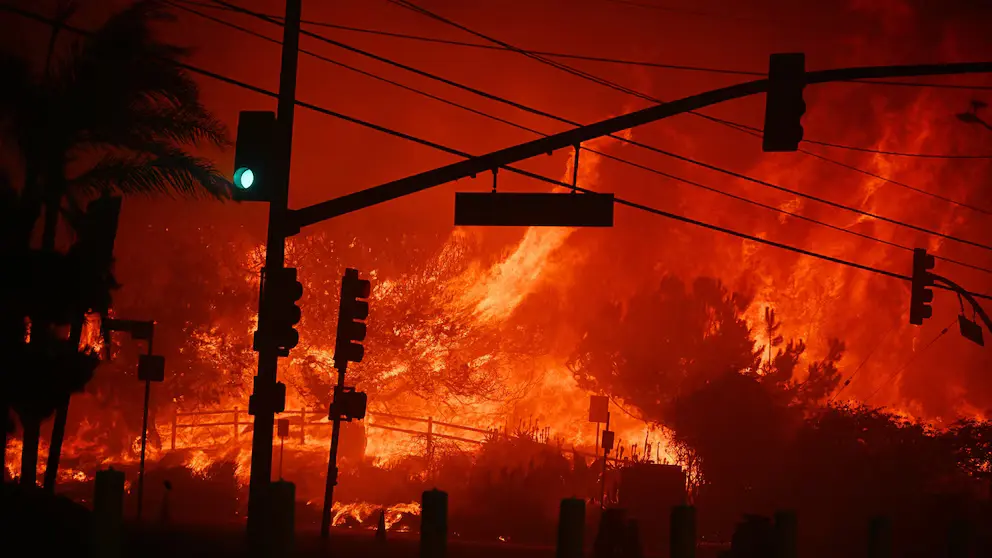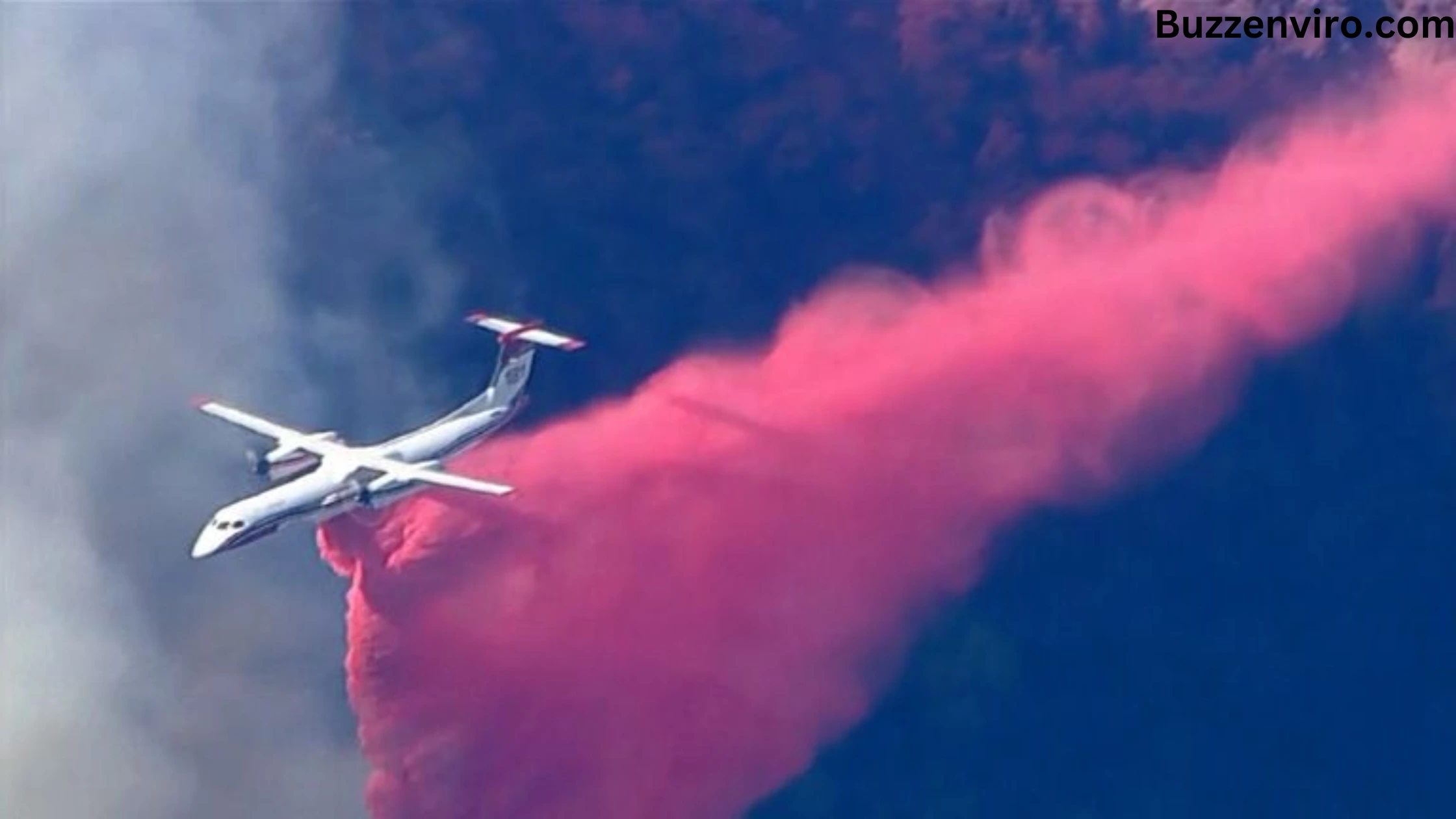Los Angeles Fire, CA — January 10, 2025

A catastrophic wildfire is currently raging through Los Angeles, with thousands of residents forced to evacuate their homes as the fire spreads uncontrollably across multiple neighborhoods. The blaze, which began early this morning in the foothills of the San Fernando Valley, has quickly turned into one of the most destructive fires in recent memory, threatening lives, homes, and critical infrastructure.
The fire, first reported at approximately 3:30 AM, has already burned over 7,500 acres of land, fueled by strong winds, dry conditions, and unusually high temperatures for January. Firefighters from across the state are working tirelessly to contain the inferno, but as of press time, it remains only 15% contained. Local authorities have declared a state of emergency, and air quality in affected areas has deteriorated, posing additional health risks to residents and emergency personnel.
Evacuations and Emergency Response

The Los Angeles Fire Department (LAFD) has issued mandatory evacuation orders for several communities, including parts of Studio City, Burbank, and Woodland Hills, where homes have already been engulfed in flames. Several shelters have been set up at local high schools, and emergency responders are working around the clock to ensure safe evacuations.
“The fire is moving incredibly fast. We’re asking people to evacuate immediately and not to wait,” said LAFD spokesperson, Captain Elena Garcia. “We’ve seen multiple structures go up in flames in just a few minutes. It’s extremely dangerous right now.”
Californian Governor Evelyn Torres has activated the National Guard to assist in both firefighting efforts and evacuation logistics. President Nathaniel Carter, currently on a diplomatic trip overseas, has pledged federal aid to support the state’s response.
Aerial Support and Firefighting Efforts

With the fire continuing to spread rapidly, aerial firefighting units have been deployed to drop fire retardant and water onto the most vulnerable areas. However, the effectiveness of these efforts has been limited due to the high winds, which have driven the fire toward heavily populated urban areas. The combination of steep terrain and the dense brush in areas like the Hollywood Hills has made ground-based firefighting operations difficult.
“We’re using every resource available, but this is a particularly volatile fire,” said LAFD Chief Alex Johnson. “Our priority right now is protecting lives, and we are working with law enforcement to ensure the safety of residents.”
Impact on Infrastructure

The fire’s path has already taken a toll on vital infrastructure. The Getty Center and other historic sites in the area are at risk, while major freeways including the 101 and 405 have been closed in multiple locations. Commuters are being advised to avoid travel to or from the affected regions, as smoke and poor visibility are making road conditions treacherous.
In addition to the destruction of homes, the fire has caused significant disruptions in power and water services. Over 50,000 residents have been left without electricity, and some areas are experiencing low water pressure due to the strain on the city’s utility systems. Emergency crews are working to restore services as quickly as possible.
A Long History of Destructive Wildfires
This current wildfire is only the latest in a string of devastating fires that have plagued Los Angeles in recent years, many of which have been fueled by increasingly volatile weather conditions, drought, and the rapid expansion of urban development into wildland areas.
The most notable of these fires occurred just over a year ago in late 2023. The “Griffith Park Fire,” which lasted for nearly two weeks, burned more than 25,000 acres, destroyed hundreds of homes, and forced the evacuation of thousands of residents. That fire, one of the largest in the city’s history, was also intensified by high winds and dry conditions, devastating neighborhoods from Eagle Rock to parts of downtown Los Angeles.
In 2020, the “Bobcat Fire,” which scorched over 115,000 acres of the Angeles National Forest, also left a deep mark on the city. Despite aggressive firefighting efforts, the Bobcat Fire burned for over two months and is still regarded as one of the most challenging wildfires ever fought by Los Angeles fire crews. At the time, it was a wake-up call for the city and the state, highlighting the intensifying nature of fire seasons linked to climate change.
“These fires are becoming more intense, more frequent, and they are getting closer to our communities,” said Dr. Liam Patel, an environmental scientist at UCLA. “Los Angeles is on the front lines of what is a larger climate crisis, and the dangers are only escalating.”
Climate Change and Wildfire Risk
Experts have long warned that Southern California’s wildfire seasons are becoming longer and more destructive due to climate change. Rising temperatures, prolonged droughts, and unpredictable winds are creating the perfect conditions for wildfires to spread quickly across the landscape. This current fire, along with others in recent years, underscores the growing urgency for both prevention and mitigation measures in the region.
“This is not just a bad season or an anomaly,” said Dr. Patel. “It is the new normal. We need to rethink how we build and maintain our communities in wildfire-prone areas, and we must prioritize greater investment in both fire prevention and preparedness.”
The Future of the Blaze
Meteorologists are predicting that the fire may continue to spread throughout the week, with wind conditions expected to worsen before a brief cold front moves in. However, it remains uncertain whether this will help extinguish the fire or intensify it further.
Fire experts are cautioning that this is not just a seasonal threat but rather a symptom of the increasing risks posed by climate change. “We are seeing more frequent, more intense fires in Southern California, and today is just a tragic example of that trend,” said Dr. Liam Patel, an environmental scientist at UCLA.
Community and Relief Efforts
While the situation remains dire, Los Angeles residents are already rallying together in support of evacuees. Local businesses, churches, and community organizations have set up donation drives for food, water, clothing, and other essentials.
“This is our city, and we’re going to help each other through this,” said Maria Hernandez, a local shop owner in West LA. “We’re seeing so many people offering shelter and support. It’s a reminder of what Los Angeles is all about—resilience.”
What to Expect Next
As firefighters continue their battle against the flames, authorities are urging residents in evacuation zones to stay vigilant, follow official instructions, and monitor updates through local media and emergency notification systems.
“We’ve faced fires before, but this one is unprecedented in its scale,” said Captain Garcia. “We ask for the public’s patience and cooperation as we work to bring this situation under control.”
For those in affected areas, the LAFD and local law enforcement advise staying inside, closing windows, and using N95 masks to protect against smoke inhalation. As the city faces yet another devastating fire season, the long-term rebuilding process will begin even as efforts to control the current blaze continue.
Follow-up Information:
For those wishing to donate or volunteer, information on emergency services and relief efforts can be found on the Los Angeles Fire Department’s website and through various local community organizations.

